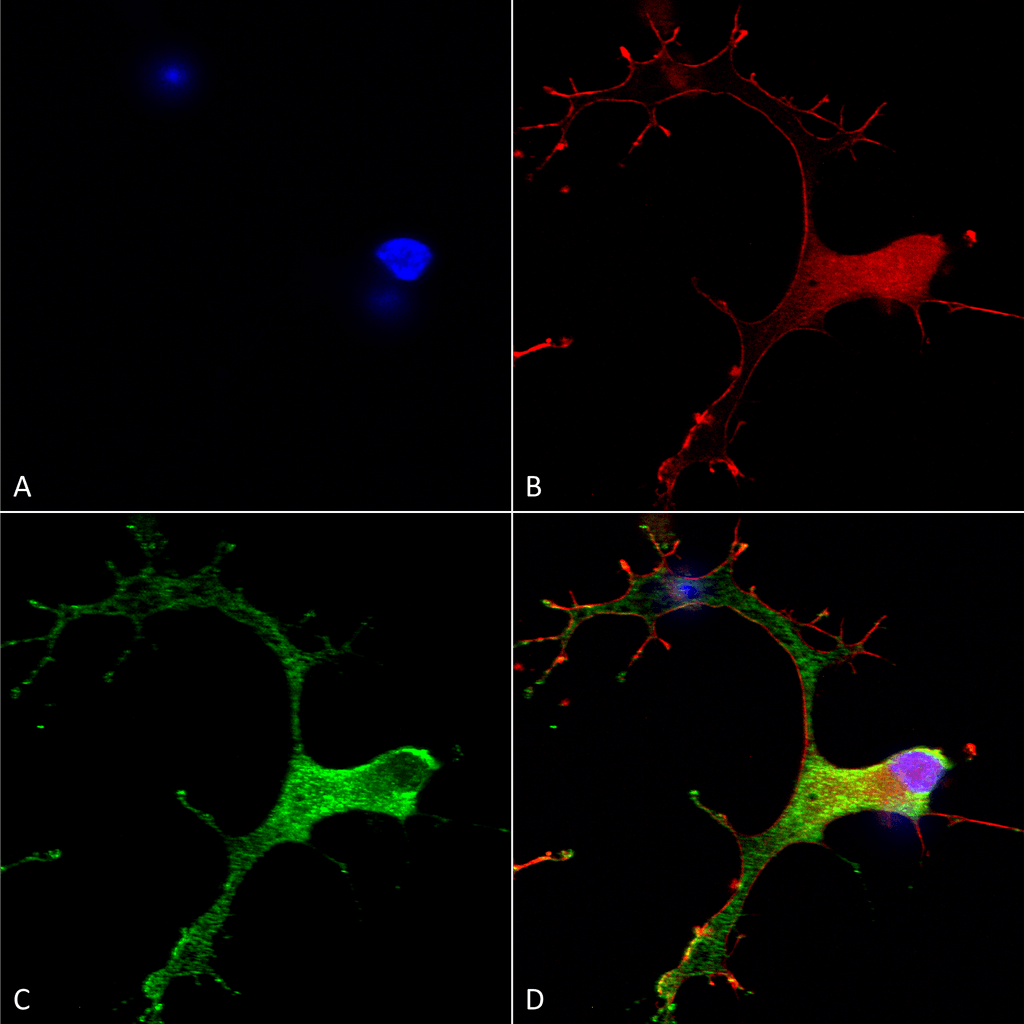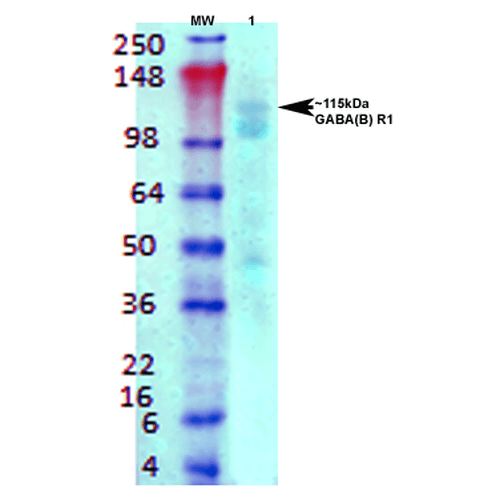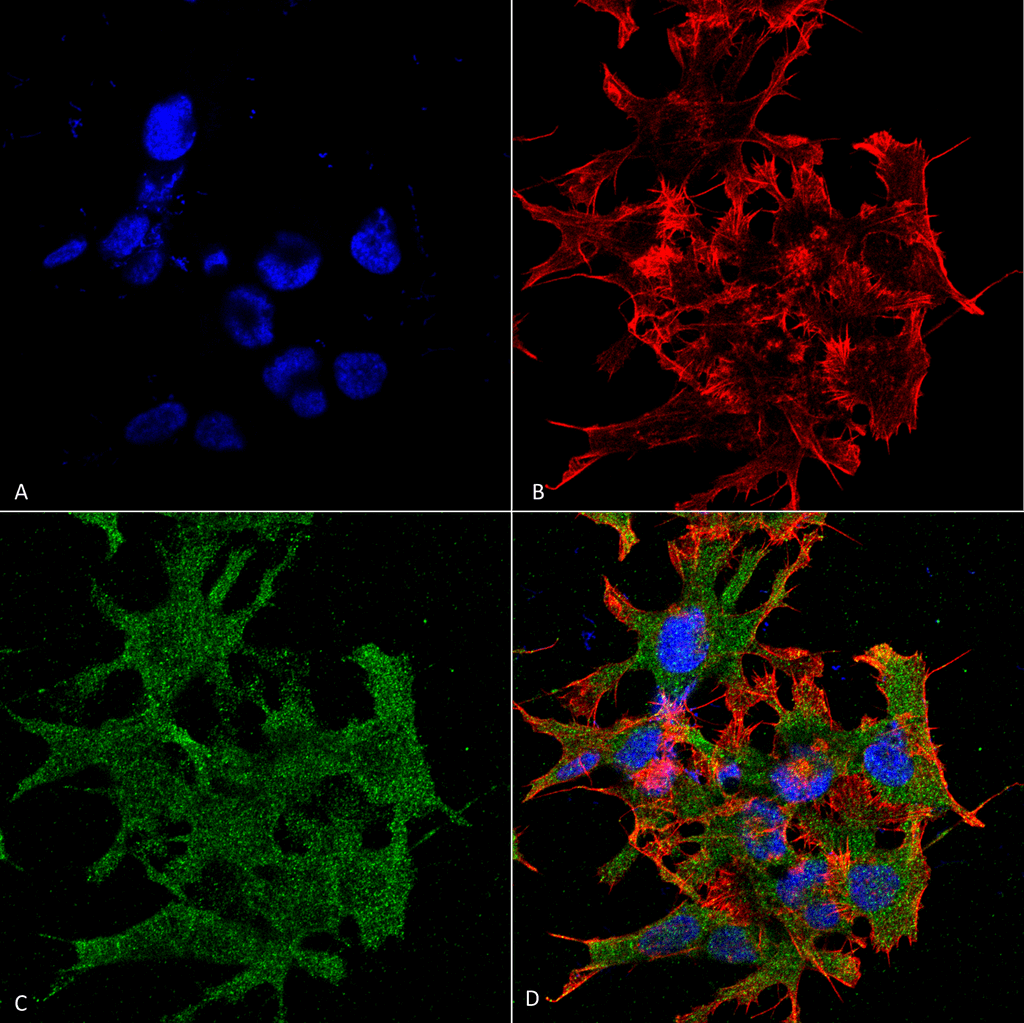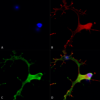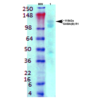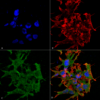Anti-GABA(B)R1 Antibody (56524)
$466.00
SKU: 56524
Categories: Antibody Products, Neuroscience and Signal Transduction Antibodies, Products
Overview
Product Name Anti-GABA(B)R1 Antibody (56524)
Description Anti-GABA (B)R1 Mouse Monoclonal Antibody
Target GABA(B)R1
Species Reactivity Human, Mouse, Rat
Applications WB,ICC/IF
Host Mouse
Clonality Monoclonal
Clone ID S93A-49
Isotype IgG1
Immunogen Fusion protein corresponding to aa 873-977 (cytoplasmic C-terminus) of rat GABA(B)R1 (accession no. NP_112290.2).
Properties
Form Liquid
Concentration 1.0 mg/mL
Formulation PBS, pH 7.4, 50% glycerol, 0.09% sodium azide.Purified by Protein G affinity chromatography.
Buffer Formulation Phosphate Buffered Saline
Buffer pH pH 7.4
Buffer Anti-Microbial 0.09% Sodium Azide
Buffer Cryopreservative 50% Glycerol
Format Purified
Purification Purified by Protein G affinity chromatography
Specificity Information
Specificity This antibody recognizes human, mouse, and rat GABA(B)R1. It does not cross- react with GABA(B)R2.
Target Name γ-aminobutyric acid type B receptor subunit 1
Target ID GABA(B)R1
Uniprot ID Q9Z0U4
Alternative Names GABA-B receptor 1, GABA-B-R1, GABA-BR1, GABABR1, Gb1
Gene Name Gabbr1
Sequence Location Cell membrane, Cell junction, synapse, postsynaptic cell membrane, Cell projection, dendrite, Perikaryon
Biological Function Component of a heterodimeric G-protein coupled receptor for GABA, formed by GABBR1 and GABBR2 (PubMed:9872315, PubMed:9872317, PubMed:9872744). Within the heterodimeric GABA receptor, only GABBR1 seems to bind agonists, while GABBR2 mediates coupling to G proteins (PubMed:9872317, PubMed:10658574). Ligand binding causes a conformation change that triggers signaling via guanine nucleotide-binding proteins (G proteins) and modulates the activity of down-stream effectors, such as adenylate cyclase (PubMed:10075644, PubMed:9872315, PubMed:9872744, PubMed:10924501). Signaling inhibits adenylate cyclase, stimulates phospholipase A2, activates potassium channels, inactivates voltage-dependent calcium-channels and modulates inositol phospholipid hydrolysis (PubMed:9069281, PubMed:10457184, PubMed:9872315, PubMed:9872744, PubMed:10924501, PubMed:10692480). Calcium is required for high affinity binding to GABA (PubMed:10692480). Plays a critical role in the fine-tuning of inhibitory synaptic transmission (PubMed:9872744). Pre-synaptic GABA receptor inhibits neurotransmitter release by down-regulating high-voltage activated calcium channels, whereas postsynaptic GABA receptor decreases neuronal excitability by activating a prominent inwardly rectifying potassium (Kir) conductance that underlies the late inhibitory postsynaptic potentials (PubMed:9872744, PubMed:10924501, PubMed:10692480). Not only implicated in synaptic inhibition but also in hippocampal long-term potentiation, slow wave sleep, muscle relaxation and antinociception (By similarity). {UniProtKB:Q9UBS5, PubMed:10075644, PubMed:10457184, PubMed:10658574, PubMed:10692480, PubMed:10924501, PubMed:9069281, PubMed:9872315, PubMed:9872744}.
Research Areas Neuroscience
Background GABA (g-aminobutyric acid) is the primary inhibitory neurotransmitter in the central nervous system and interacts with three different receptors: GABA(A), GABA(B), and GABA(C). GABA(B) receptor is coupled to G proteins that modulate slow inhibitory synaptic transmission. Functional GABA(B) receptors form heterodimers of GABA(B)R1 and GABA(B)R2 in which GABA(B)R1 binds a ligand and GABA(B)R2 is the primary G protein contact site.
Application Images




Description Immunocytochemistry/Immunofluorescence analysis using Mouse Anti-GABA-B Receptor 1 Monoclonal Antibody, Clone S93A-49 (56524). Tissue: Neuroblastoma cells (SH-SY5Y). Species: Human. Fixation: 4% PFA for 15 min. Primary Antibody: Mouse Anti-GABA-B Receptor 1 Monoclonal Antibody (56524) at 1:50 for overnight at 4°C with slow rocking. Secondary Antibody: AlexaFluor 488 at 1:1000 for 1 hour at RT. Counterstain: Phalloidin-iFluor 647 (red) F-Actin stain; Hoechst (blue) nuclear stain at 1:800, 1.6mM for 20 min at RT. (A) Hoechst (blue) nuclear stain. (B) Phalloidin-iFluor 647 (red) F-Actin stain. (C) GABA-B Receptor 1 Antibody (D) Composite.

Description Western Blot analysis of Rat brain membrane lysate showing detection of GABA B Receptor 1 protein using Mouse Anti-GABA B Receptor 1 Monoclonal Antibody, Clone S93A-49 (56524). Primary Antibody: Mouse Anti-GABA B Receptor 1 Monoclonal Antibody (56524) at 1:1000.

Description Immunocytochemistry/Immunofluorescence analysis using Mouse Anti-GABA-B Receptor 1 Monoclonal Antibody, Clone S93A-49 (56524). Tissue: Neuroblastoma cell line (SK-N-BE). Species: Human. Fixation: 4% Formaldehyde for 15 min at RT. Primary Antibody: Mouse Anti-GABA-B Receptor 1 Monoclonal Antibody (56524) at 1:100 for 60 min at RT. Secondary Antibody: Goat Anti-Mouse ATTO 488 at 1:100 for 60 min at RT. Counterstain: Phalloidin Texas Red F-Actin stain; DAPI (blue) nuclear stain at 1:1000, 1:5000 for 60min RT, 5min RT. Localization: Cell Membrane. Magnification: 60X. (A) DAPI (blue) nuclear stain. (B) Phalloidin Texas Red F-Actin stain. (C) GABA-B Receptor 1 Antibody. (D) Composite.
Handling
Storage This product is stable for at least 1 year at -20°C. Freeze in multiple aliquots to avoid repeated freeze-thaw cycles.
Dilution Instructions Dilute in PBS or medium that is identical to that used in the assay system.
Application Instructions Immunoblotting: use at 1-2ug/mL. A band of ~115kDa is detected.
Immunocytochemistry: use at 1-5ug/mL.
These are recommended concentrations.
Enduser should determine optimal concentrations for their applications.
Positive control: Rat brain membranes.
Immunocytochemistry: use at 1-5ug/mL.
These are recommended concentrations.
Enduser should determine optimal concentrations for their applications.
Positive control: Rat brain membranes.
References & Data Sheet
Data Sheet  Download PDF Data Sheet
Download PDF Data Sheet
 Download PDF Data Sheet
Download PDF Data Sheet

